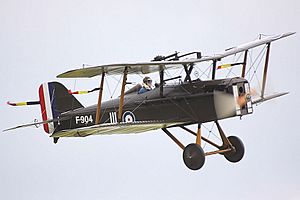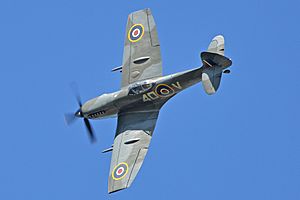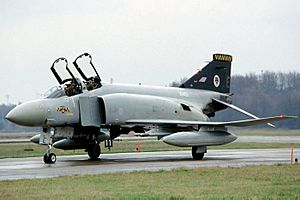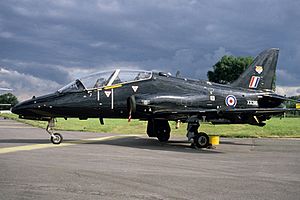No. 74 Squadron RAF facts for kids
Quick facts for kids No. 74 Squadron RAF |
|
|---|---|
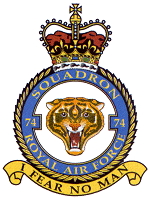
Squadron badge
|
|
| Active | Royal Flying Corps 1 July 1917 – 1 April 1918 Royal Air Force 1 April 1918 – 3 July 1919 3 September 1935 – 25 August 1971 19 October 1984 – 1 October 1992 5 October 1992 – 22 September 2000 |
| Country | |
| Allegiance | British Armed Forces |
| Branch | |
| Type | Flying squadron |
| Role | disbanded |
| Nickname(s) | Tiger Squadron Trinidad |
| Motto(s) | I Fear No Man |
| Mascot(s) | Bengal tiger |
| Former aircraft | see below |
| Battle honours |
|
| Insignia | |
| Squadron badge heraldry | A tiger's face. Approved by King George VI in February 1937. (Developed from an unofficial emblem used during the First World War.) |
| Squadron flash |  |
| Squadron codes | JH (Feb 1939 – Sep 1939) ZP (Sep 1939 – Apr 1942) 4D (Apr 1944 – Apr 1951) TA–TZ (Hawks) |
No. 74 Squadron, also known as the 'Tiger Squadron', was a famous squadron of the Royal Air Force (RAF). It got its nickname from its cool tiger-head badge. This squadron flew powerful fighter aircraft from 1917 all the way into the 1990s. Later, it switched to training planes before it was officially closed down in 2000.
The squadron started in 1917 as a training unit. But by 1918, it became a fighter squadron on the Western Front during the First World War. Its pilots were known for being super brave and aggressive, just like tigers! Many top pilots, called aces, were part of No. 74 (F) Squadron. They achieved an amazing 225 victories in only seven months.
'The Tigers' also played a big part in the Second World War, especially during the Battle of Britain. After the war, they were among the first to fly jet fighters like the Gloster Meteor. In 1960, they became the first RAF unit to fly the super-fast English Electric Lightning F.1. They even had an amazing aerobatic display team called 'The Tigers' that flew nine Lightnings. This team was the first in the world to fly planes that could go twice the speed of sound!
From 1984, 'The Tigers' flew unique McDonnell Douglas F-4J(UK) Phantoms from RAF Wattisham. These were later replaced by other Phantom models. The squadron spent its last eight years training future fighter pilots on BAe Hawk T.1/T.1A jets at RAF Valley. No. 74 (Reserve) Squadron was finally disbanded on 22 September 2000.
History of the Tiger Squadron
First World War Adventures
No. 74 Squadron first formed at Northolt on 1 July 1917. It was called No. 74 (Training Depot) Squadron of the Royal Flying Corps (RFC). At first, it was a training unit, flying planes like the Avro 504K.
In February 1918, the squadron became a front-line fighter unit, known as No. 74 (Fighter) Squadron. On 20 March 1918, they received their first fighter planes, the Royal Aircraft Factory S.E.5a. Soon after, they were sent to France.
Their first battle was on 12 April near Merville. They fought against German planes, and one of their pilots, Mick Mannock, scored their first victory. In just 70 days, No. 74 (F) Squadron shot down 100 enemy planes while losing only one of their own. The squadron stayed in France until February 1919, then returned to England and was disbanded on 3 July 1919.
During its seven months of fighting, the squadron was credited with 225 victories. Many famous aces flew with them, including Victoria Cross winner Major Edward 'Mick' Mannock and Ira 'Taffy' Jones.
Between the World Wars
The squadron was brought back to life on 3 September 1935. This happened in a unique way: different parts of other squadrons came together on a ship heading to Malta. Once there, No. 74 (F) Squadron flew Hawker Demon two-seater fighters. For security reasons, they couldn't use their squadron number at first. They were just called 'Demon Flights'.
In July 1936, the squadron returned to England, arriving at RAF Hornchurch in September. In February 1937, the squadron's tiger face badge was officially approved by King George VI. 'The Tigers' then got new planes, Gloster Gauntlets, in April 1937. These planes were part of the new RAF Fighter Command. In February 1939, they started flying the famous Supermarine Spitfire Mk.I.
Second World War Battles
Fighting in France and Britain
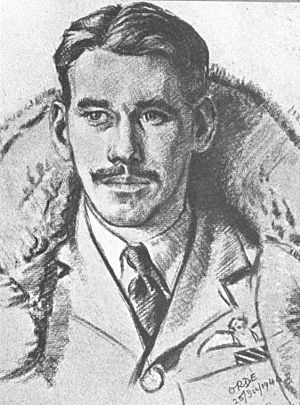
When the war started, No. 74 (F) Squadron was based at RAF Rochford. On 6 September 1939, there was a confusing incident known as the Battle of Barking Creek. Spitfires from No. 74 (F) Squadron were ordered to attack what they thought were enemy planes. Sadly, it turned out to be an unfortunate error involving friendly RAF aircraft. One pilot was killed, marking the first RAF operational death of the war.
The squadron first saw real combat in May 1940 during the evacuation from Dunkirk. These battles were very tough for both pilots and planes. After that, No. 74 (F) Squadron fought bravely throughout the Battle of Britain. On 11 August, they claimed 24 victories in one day.
The squadron moved to different bases for rest and to get new planes. In September 1940, they replaced their Spitfire Mk.Is with the newer Mk.IIa. They moved back south to RAF Biggin Hill in October for the final part of the Battle of Britain. Between November and December 1940, 'the Tigers' destroyed 38 enemy aircraft.
After the Battle of Britain was won, the squadron moved to RAF Manston in February 1941. They then went to northern England and later to Wales and Northern Ireland to regroup. During this time, the Governor of Trinidad and Tobago gave Spitfires to No. 74 (F) Squadron. Because of this, 'the Tigers' were also known as the 'Trinidad Squadron' for many years.
Middle East and Europe's Freedom
In April 1942, the squadron moved to the Middle East, arriving in Egypt in June. The ship carrying their planes sank, leaving them without aircraft. They moved to Palestine and worked as a maintenance unit for USAAF bombers. In December 1942, they finally got planes again, flying Hurricane Mk.IIBs. They operated from Iraq and Iran.
In May 1943, 'the Tigers' moved back to Egypt to patrol shipping lanes. On 23 July, they attacked targets on Axis-occupied Crete, causing a lot of damage. In September 1943, the squadron switched back to Spitfires (Mk.Vbs and Mk.Vcs) and moved to Cyprus for the failed Dodecanese campaign. They returned to Egypt and later received Mk.IX Spitfires, then Mk.XVIes in March 1944.
No. 74 (F) Squadron returned to Britain in April 1944, just in time for Operation Overlord, the Allied invasion of Normandy. They flew Spitfire Mk.IX HFs, attacking German railway yards and escorting Allied bombers. On 3 July, they moved to RAF Tangmere and then to Sommervieu, Normandy in August 1944. From there, they supported the Allied advance through France, Belgium, and the Netherlands.
In March 1945, the squadron received Spitfire Mk.XVIs. On 16 April, 'the Tigers' were based in Germany, flying reconnaissance missions. It was there that they heard Germany had surrendered. The squadron finally left Germany on 11 May 1945, returning home to Britain.
After the War
Jets: Meteors, Hunters, and Lightnings
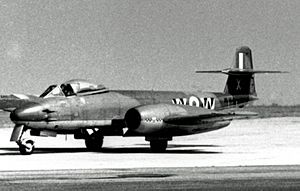
Back in England, No. 74 (F) Squadron got its first jet aircraft, the Gloster Meteor F.3. They were based at RAF Colerne. The squadron became part of the first all-jet fighter wing with other squadrons. From December 1947, they started flying the improved Meteor F.4s, and then the Meteor F.8 in October 1950. By 1954, their Meteors started to have cool 'tiger stripe' markings again!
After 12 years of flying Meteors, No. 74 (F) Squadron switched to the Hawker Hunter F.4 in March 1957. They quickly upgraded to Hunter F.6s by January 1958.
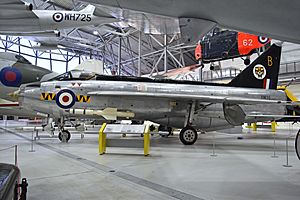
On 8 June 1959, 'the Tigers' moved to RAF Coltishall to get the English Electric Lightning F.1 in June 1960. They were the very first squadron in the RAF to receive this amazing jet! In 1962, No. 74 (F) Squadron formed an aerobatic display team called 'The Tigers'. This team became the RAF's official display team.
On 2 March 1964, the squadron moved to RAF Leuchars in Scotland and got the Lightning F.3. While there, they hosted their first Tiger Meet in July 1966. This was a gathering of squadrons that used a tiger as their symbol. 'The Tigers' upgraded to Lightning F.6s in November 1966.
The squadron moved to RAF Tengah in Singapore in June 1967. In June 1969, four Lightning F.6s from the squadron flew 2,000 miles to Australia. This was the longest non-stop flight ever made by a Lightning. In 1971, the squadron flew its Lightnings to RAF Akrotiri in Cyprus and then disbanded on 25 August 1971.
Phantoms, Hawks, and Final Disbandment
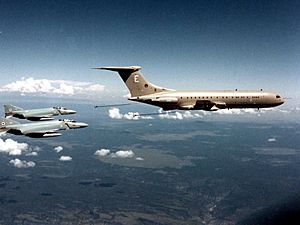
After 13 years, No. 74 (Fighter) Squadron was brought back to life at RAF Wattisham on 19 October 1984. They flew special McDonnell Douglas F-4J Phantom IIs that used to belong to the US Navy. These planes were bought by the RAF to fill a gap after the Falklands War. The planes were updated and painted in a unique duck egg blue color. They were flown across the Atlantic Ocean to their new home.
In July 1985, 'the Tigers' went to RAF Akrotiri for training. They even practiced fighting against US Navy Grumman F-14A Tomcats from aircraft carriers. The squadron was fully ready for operations by 31 December 1985.
No. 74 (F) Squadron made its first intercept with a Phantom on 7 April 1986, when they identified a Russian Tupolev Tu-142 Bear-F plane. On 1 July 1987, 'the Tigers' celebrated their 70th anniversary by breaking the speed record from London to Edinburgh, doing it in just 27 minutes and 3 seconds! Sadly, on 26 August 1987, the squadron lost an F-4J(UK) Phantom in an accident near Aberystwyth, Wales, and both pilots were killed.
'The Tigers' flew their unique F-4J(UK)s until January 1991. Then, they switched to other Phantom FGR.2s. Because the Cold War ended, the RAF decided to retire all remaining Phantom squadrons.
No. 74 (F) Squadron took part in its second-to-last Tiger Meet as a fighter squadron in Spain in May 1992. On 13 June 1992, both No. 56 (F) Squadron and No. 74 (F) Squadron flew a special formation of 16 Phantoms over Buckingham Palace for Queen Elizabeth II's birthday. This was one of the last big flights for the Phantom fleet.
By August 1992, 'the Tigers' were the last remaining Phantom squadron in the RAF. In its last year, No. 74 (F) Squadron performed aerobatic displays around the country. They held a mini Tiger Meet at RAF Wattisham in September to mark the Phantom's retirement. The squadron finally disbanded on 1 October 1992.
However, on 5 October 1992, No. 74 (Reserve) Squadron was formed again! This time, they flew the British Aerospace Hawk T.1 at RAF Valley. Their job was to train future fighter pilots. At the 1993 Tiger Meet, No. 74 (R) Squadron won the special 'Silver Tiger' trophy. This was a great achievement for a training unit! No. 74 (R) Squadron was finally disbanded for the last time on 22 September 2000.
Famous Pilots
Here are some famous pilots who flew with No. 74 Squadron:
- Keith Caldwell
- John Freeborn – He had 12 kills and flew more operational hours than any other Battle of Britain pilot in his squadron.
- A. G. 'Sailor' Malan – He achieved 32 victories.
- Edward Mannock – He had 61 victories, with 35 of them while flying with No. 74 Squadron.
- John Mungo-Park
Aircraft Operated
Here are the different types of aircraft that No. 74 Squadron flew over the years:
- Avro 504K (Jul 1917 – Mar 1918)
- Sopwith Pup (Jan 1918 – Mar 1918)
- Sopwith Scout (Jan 1918 – Mar 1918)
- Royal Aircraft Factory S.E.5a (Mar 1918 – Feb 1919)
- Hawker Demon Mk.I (Sep 1935 – Apr 1937)
- Gloster Gladiator Mk.I (Mar 1937)
- Gloster Gauntlet Mk.II (Mar 1937 – Feb 1939)
- Miles Magister Mk.I (1938–1944)
- Supermarine Spitfire Mk.I/Ia (Feb 1939 – Sep 1940)
- Supermarine Spitfire Mk.IIa/IIb (Jun 1940 – Dec 1941)
- Vickers-Supermarine Spitfire Mk.Vb (May 1941 – Mar 1942)
- Hawker Hurricane Mk.I/IIb/IIc (Dec 1942 – Sep 1943)
- Vickers-Supermarine Spitfire Mk.Vb (Sep 1943 – Apr 1944)
- Vickers-Supermarine Spitfire Mk.Vc (Sep 1943 – Apr 1944)
- Vickers-Supermarine Spitfire Mk.IX (Oct 1943 – Apr 1944)
- Vickers-Supermarine Spitfire LF.IXe (Apr 1944 – Mar 1945)
- Vickers-Supermarine Spitfire LF.XVIe (Mar 1945 – May 1945)
- Gloster Meteor F.3 (May 1945 – Mar 1948)
- Gloster Meteor F.4 (Dec 1947 – Oct 1950)
- Gloster Meteor T.7 (1950–1957)
- Gloster Meteor F.8 (Oct 1950 – Mar 1957)
- Hawker Hunter F.4 (Mar 1957 – Jan 1958)
- Hawker Hunter F.6 (Nov 1957–1960)
- Hawker Hunter T.7 (1958–1966)
- English Electric Lightning F.1/F.1a (Jun 1960 – Apr 1964)
- English Electric Lightning F.3 (Apr 1964 – Sep 1967)
- English Electric Lightning T.4 (1961–1966)
- English Electric Lightning T.5 (Jun 1967 – Aug 1971)
- English Electric Lightning F.6 (Jun 1966 – Aug 1971)
- McDonnell Douglas F-4J(UK) Phantom (Aug 1984 – Jan 1991)
- McDonnell Douglas Phantom FGR.2 (Jan 1991 – Oct 1992)
- British Aerospace Hawk T.1/T.1A (Oct 1992 – Sep 2000)
Images for kids
-
Avro 504K at the Shuttleworth Collection. This was the first aircraft type that No. 74 (Training Depot) Squadron operated in 1917.
-
Hawker Demons similar to those No. 74 (F) Squadron operated from 1935 to 1937 in Malta.
-
Supermarine Spitfire Mk.Ia P9306, which served with No. 74 (F) Squadron in 1940, on display at the Museum of Science and Industry in Chicago.
-
Hawker Hunter Mk.51 painted up as Hunter F.4 XE683 of No. 74 (F) Squadron at the City of Norwich Aviation Museum.
-
English Electric Lightning of No. 74 (F) at RAF Leuchars.
See also
- List of RAF squadrons


